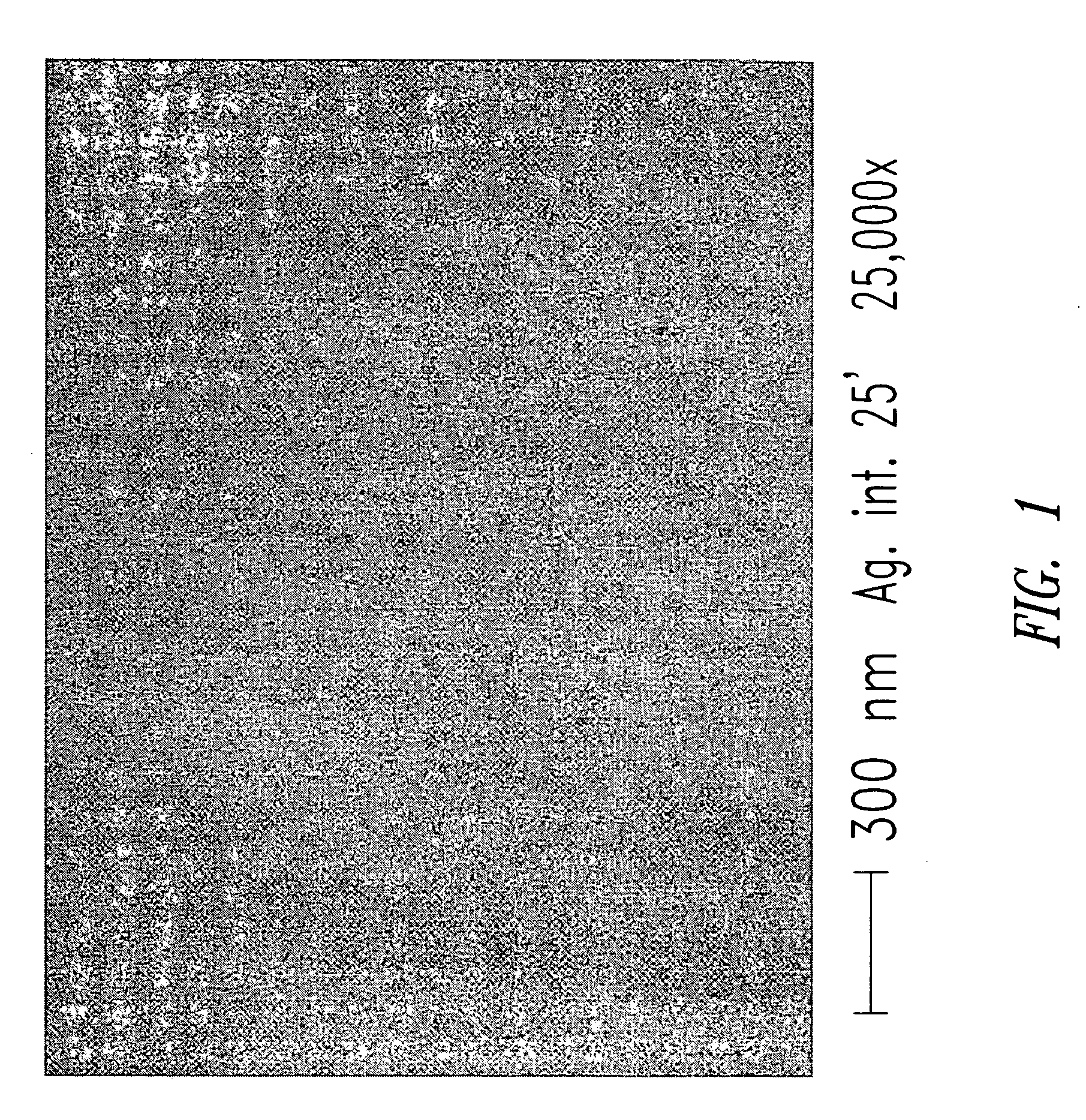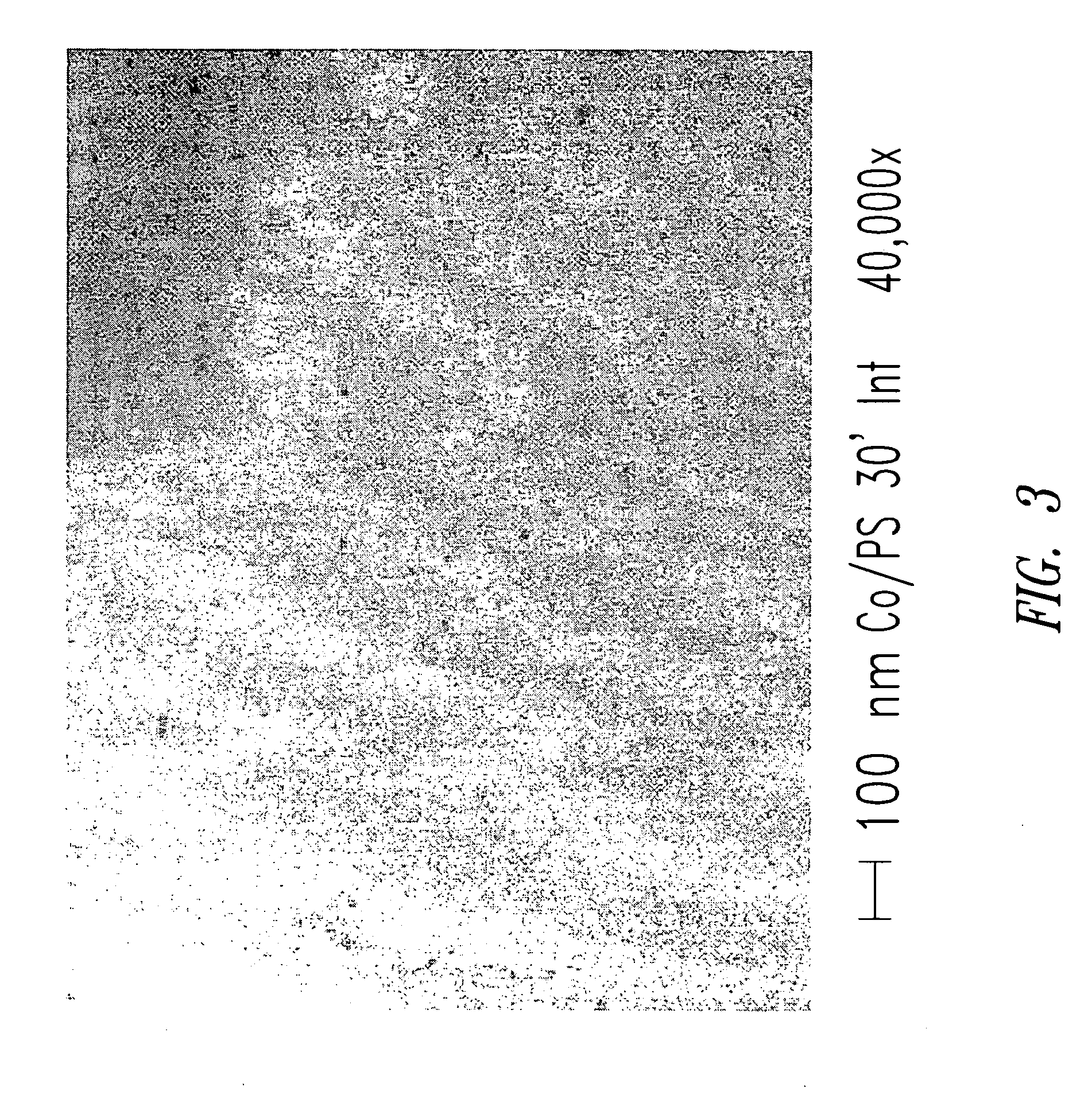Process for the preparation of a composite polymeric material
- Summary
- Abstract
- Description
- Claims
- Application Information
AI Technical Summary
Benefits of technology
Problems solved by technology
Method used
Image
Examples
example 1
[0100]FIG. 1 shows an electronic transmission micrography of a polystyrene sample comprising silver monodispersed nanoparticles with mean diameter of about 20 nm.
[0101] The polystyrene processed in the form of granules is an atactic polystyrene (aPS) acquired from Aldrich (mean Mw ca. 230,000, mean Mn ca. 140,000 and Tg=94° C.).
[0102] The thermolytic precursor used, silver dodecanthiolate [Ag(SC12H25)2], was mixed with the polymer through a solution in an amount equal to 10% by weight with respect to the total weight of polymer and precursor, obtaining a homogeneous dispersion of polymer and precursor.
[0103] In particular, the aPS was dissolved in a chloroform solution at a concentration equal to 20% by weight with respect to the total weight. Similarly, the silver dodecanthiolate was dissolved also in chloroform at a concentration equal to 40% by weight with respect to the total weight.
[0104] The two solutions were mixed for some minutes on a plate with magnetic agitator and su...
example 2
[0108]FIG. 3 shows an electronic transmission micrography of a polystyrene sample comprising cobalt monodispersed nanoparticles with mean diameter of about 5 nm.
[0109] The polystyrene processed in the form of granules is an atactic polystyrene (aPS) acquired from Aldrich (mean Mw ca. 230,000, mean Mn ca. 140,000 and Tg=94° C.).
[0110] The thermolytic precursor used, cobalt dodecanthiolate [Co(SC12H25)2], was mixed with the polymer through a solution in an amount equal to 10% by weight with respect to the total weight of polymer and precursor, obtaining a homogeneous dispersion of polymer and precursor.
[0111] In particular, the aPS was dissolved in a chloroform solution at a concentration equal to 20% by weight with respect to the total weight. Similarly, the cobalt dodecanthiolate was dissolved always in chloroform at a concentration equal to 40% by weight with respect to the total weight.
[0112] The two solutions were mixed for some minutes on a plate with magnetic agitator and s...
example 3
[0114]FIG. 4 shows an electronic transmission micrography of a polystyrene sample comprising cobalt monodispersed nanoparticles with mean diameter of about 20 nm.
[0115] The heated homogeneous dispersion, identical to the one of the example 2, was obtained by dispersing the precursor in the molten polymer directly during the heating step inside the mixer.
[0116] The present invention is based, in practice, on having realized a process “in situ” wherein the nanometric inclusions are obtained by the precursor dispersed directly in the molten polymer.
[0117] According to the invention, it is necessary to have an intimate and uniform mixing between polymer and precursor, which can be obtained for example by thermomixing or dispersion through a solution, for then obtaining the fission of the precursor directly in the molten polymer.
[0118] The polymeric material comprising the uniformly dispersed nanometric inclusions can be thus stocked, for example in the form of pellets, granules, sph...
PUM
| Property | Measurement | Unit |
|---|---|---|
| Fraction | aaaaa | aaaaa |
| Fraction | aaaaa | aaaaa |
| Percent by mass | aaaaa | aaaaa |
Abstract
Description
Claims
Application Information
 Login to View More
Login to View More - R&D
- Intellectual Property
- Life Sciences
- Materials
- Tech Scout
- Unparalleled Data Quality
- Higher Quality Content
- 60% Fewer Hallucinations
Browse by: Latest US Patents, China's latest patents, Technical Efficacy Thesaurus, Application Domain, Technology Topic, Popular Technical Reports.
© 2025 PatSnap. All rights reserved.Legal|Privacy policy|Modern Slavery Act Transparency Statement|Sitemap|About US| Contact US: help@patsnap.com



